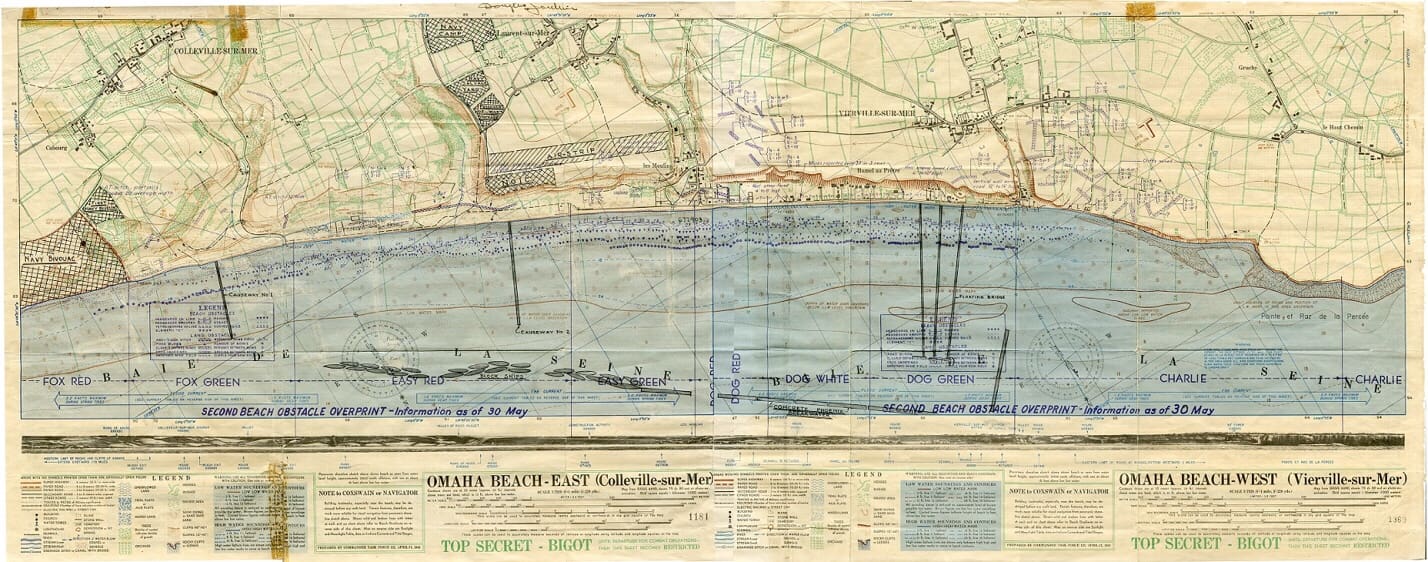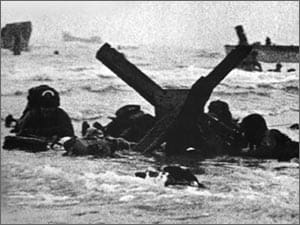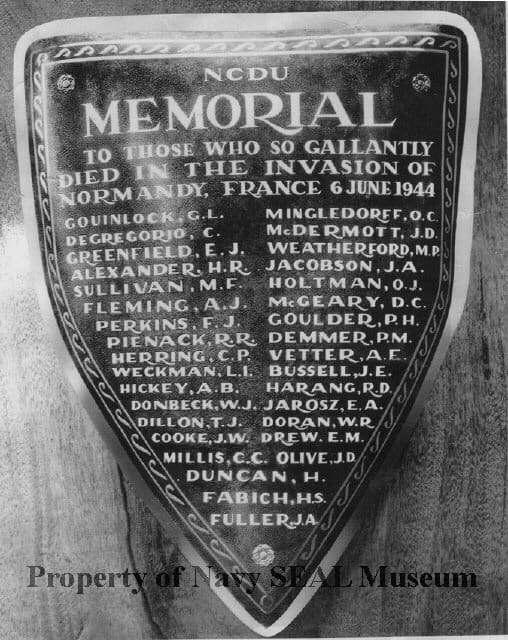When the U.S. entered WWII, the Navy knew it would need men that would have to go in to reconnoiter the landing sites, locate and destroy obstacles and defenses. The Army and Navy established the Amphibious Scout and Raider School at Fort Pierce, Florida in 1943 to train men in the specialty of amphibious raids and tactics. Most of these men used their skills throughout North Africa, the Pacific, and the Normandy landings. In 1943, the Navy created a large dedicated force for this task called the Naval Combat Demolition Unit, or NCDU, that were also trained at Fort Pierce, Florida.
The Navy had a significant role in the June 6, 1944, D-Day invasion. However, long before that day, the Naval Combat Demolition Units (NCDUs) had to perform pre-invasion recons of the beaches and shore placements, even going as far as to bring buckets of sand back to make sure the beach could support the specialized amphibious tanks that would go ashore to provide close-in gun support. The Navy’s role in D-day was to provide shore bombardment, the follow-up gunfire support, plus transporting and landing many of the Army troops who stormed ashore.
The Naval Beach Battalions were naval elements of the Army Engineer Special Brigades for the invasion of Normandy. NCDUs were formed up about one year before D-Day. They were made up of 1 officer and 5 enlisted men. They trained alongside the Scouts and Raiders at Fort Pierce. They were organized by Lt. Cdr. Draper Kaufman, an explosives expert, with the specific goal of clearing beach obstacles.
In Late 1943, 10 NCDUs had arrived in England from Fort Pierce, FL, to meet and train with their British counterparts for future missions. In early 44, the units split and joined with the 2nd, 6th, and 7th USN Beach Battalions, the organizations, set up to coordinate and facilitate the Army landings. At this time, eight additional six-man units arrived from the U.S. to be split among the Beach Battalions.
The NCDU men were not the Frogman you would see in the movies of the same name. They were more like the man you would see in the movie Carlson’s Raiders. They mainly operated from rubber rafts and were not expected to spend long periods in the water. They wore fatigues, combat boots, and steel helmets. The men were in excellent physical condition but operated mainly in shallow water.
The more recons that were done on Hitler’s “Atlantic Wall” showed it becoming more formidable by the months. So as new personal from Ft Peirce arrived and the subsequent arrival of some Army Combat Engineers enabled each of the NCDUs to double in size. In April, of 44 the officers leading the Navy units and their Army counterparts were briefed about a hypothetical long, wide gradual sloping sand beach with a 25-foot tide change.

On that beach, and extending into the surf, they could expect minefields and a variety of devilishly designed obstacles placed to block and cripple landing craft. To clear the beach, the invasion planners envisioned an aerial and naval bombardment sweeping the coastline. Then the initial wave of infantry, supported by specially designed amphibious tanks, would land during low tide after dawn and rush to secure the beaches. Following in their wake, the NCDUs would land with a mission to blow a 50-yard gap in the German obstacles and place markers so landing craft coming in later that morning at high tide would have a straight, unobstructed path leading to the beach.
The Americans were assigned beaches “Utah” and “Omaha.” At 0630, H-Hour, on the morning of June 6, 1944, 11 NCDUs came in with 8th Infantry Regiment at Utah. With the Army securing the beach, the Navy demolition men went to work and quickly blew eight 50-yard gaps and had enough time to expand one gap to 700 yards. This allowed successive waves of troops, ashore and quickly secured a substantial beachhead by midday.

Four sailors were killed on Utah, and 11 others were wounded. Because of their efficient work, the units on Utah beach received a Navy Unit Commendation.
At Omaha, the Germans were better entrenched and had built a more robust network of obstacles. Sixteen teams, each with 7 Navy and 5 Army engineers tasked with clearing fifty-foot-wide corridors through the beach obstacles. One of the first teams ashore was wiped out as it landed, and another lost all but one man as it prepared to set off its lengths of twenty-pound explosive charges. Casualties were appalling: of the 175 NCDU men at Omaha, thirty-one were killed and sixty wounded—a 53 percent loss rate. It also didn’t help that the pre-invasion air and sea bombardments mostly missed their marks. As a result, the invaders were savaged by heavy artillery, mortar and machine-gun fire that ripped into the NCDU landing craft. Also, choppy seas swamped many of the amphibious tanks, depriving the invaders of needed of close-in firepower. However, the survivors succeeded in clearing five main channels through the obstacles and three partial channels before the rising tide forced them to withdraw. By the end of the day, about one-third of the obstacles had been destroyed or removed.
Through the gaps poured the reinforcements needed to hold off any counter attacks and to take the fight inland. Seven sailors earned the Navy Cross for their work that day. For their heroic actions, the Omaha NCDUs received a Presidential Unit Citation.
On Gold, Juno, and Sword the British beaches the NCDUs relied heavily on Royal Marine commandos specially trained for the task. Their mission and equipment were similar to their American counterparts but owing to less effective defenses; the Marines sustained fewer casualties, then the Americans did.

www.wwiifoundation.org/2014/09/10/ernie-corvese-us-navy-ncdu-d-day


Thanks for the great history. Another example of the Greatest Generations bravery and sacrifice.
There is a museum dedicated to the UDT/SeALS and raiders at Ft Pierce, FL. I have taken my family several times, always learn something new. It has expanded quite a bit since GWOT started. well worth a visit if in FL.
https://www.navysealmuseum.org/
Excellent history there. Reminds me of my favourite quote: ‘the problem today is you can live your entire life without knowing if you’re a coward or not’.
Draper Kauffman is a good study for a little more background on the subject, those were his men. Incredibly tough task on those beaches made more difficult because of the inability of air and artillery strikes hitting their targets.
Reprint of NCDU Manual, and D-Day UDT after-action report: http://www.amazon.com/B07S1S621W/?tag=looscnbooks-20